Personality and Temperament
Stunning looks and an intriguing personality make the Bombay cat a charming addition to any household. These medium-sized shorthair cats are absolutely gorgeous thanks to their pure black coats and their brilliant copper-colored eyes.
Similar to the Burmese cats that make up the breed's foundation, Bombays tend to be chatty. At the same time though, they are less vocal and far less demanding than their Burmese cousins – probably due to the calming influence of the American and British shorthair cats that make up the other half of the Bombay hybrid.
As family pets go, Bombay cats are outstanding. Rather than bonding with a single individual, they are affectionate toward everyone they know – and they have a tendency to get along well with other pets.
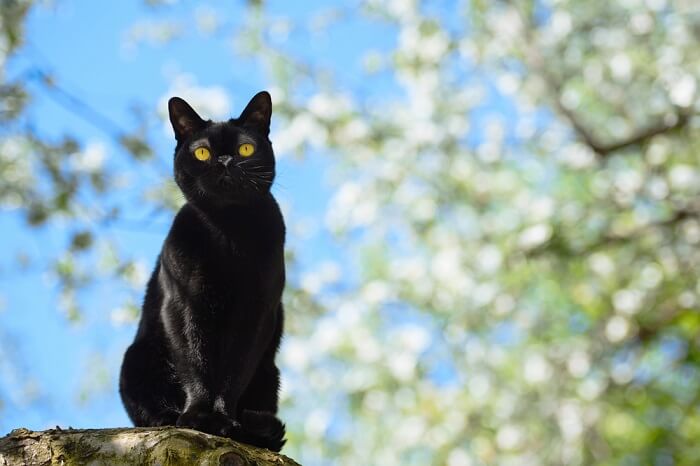

Care
Nutrition
Grooming
Exercise
Health
The Bombay cat does not have any special nutritional requirements. At the same time, it's important to offer a high-quality diet to ensure that your pet stays healthy for years to come.
Bombay cats are low maintenance thanks to their shorthair coats. Still, you may want to give your cat a quick brush once a week or so, simply to remove loose hair and reduce the potential for the excessive shedding and hairballs that come with it.
The Bombay cat is frisky, with a strong play drive. These cats enjoy games of all kinds and they love to climb. A well-stocked basket of toys, multiple scratching posts, and a stout cat tree are essential for keeping this lively feline entertained.
These cats typically enjoy good health and has a fairly long lifespan that averages about 15 years. Even so, Bombays can occasionally have health concerns including breathing problems caused by their short nose, excessive tearing in the eyes, and hypertrophic cardiomyopathy.
History
If the Bombay cat reminds you of a miniature black panther, you’re not mistaken! Nikki Horner, founder of the Bombay cat breed, started out with the intention of developing a cat that looked like a small panther. She crossed a black American shorthair male with a female Burmese and eventually the Bombay came into being.
The breed took more than a decade to develop, with American shorthairs and British shorthairs contributing to the cat's medium size and robust nature. The first breeding took place in the 1950s and despite the cat's stunning appearance and appealing personality, CFA did not grant official acceptance for registration until 1970.
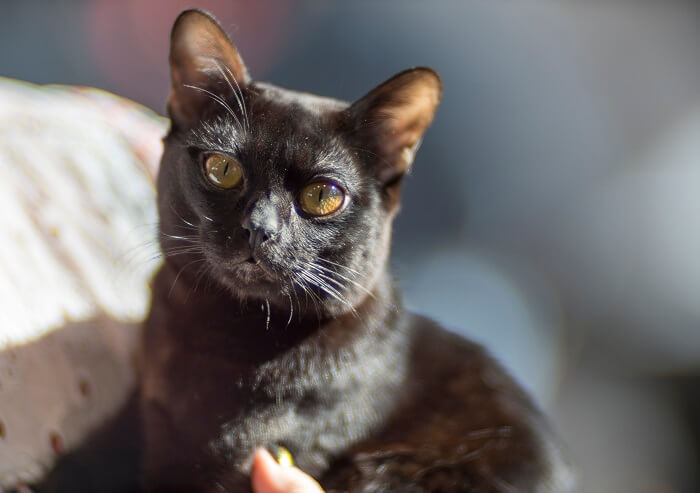

Eyes
Legs & Paws
Tail
The Breed Standard
Body
Head
Ears
Coat
Color
FAQ
How much does a Bombay cat cost?
Bombay cats cost between $400-$2,000.
How big do Bombay cats get?
Bombay cats tend to be medium in size. A fully grown Bombay cat might weigh between 6-11 pounds or more and range in height anywhere from about 8"-10" inches tall.
How long do Bombay cats live?
The Average lifespan for Bombay is 12-16 years.
Do Bombay cats shed?
Bombay are short-haired cats. Therefore, they do not shed as much as long-haired cat breeds.











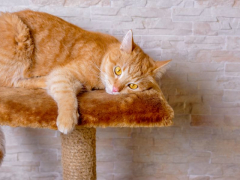
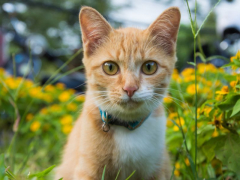

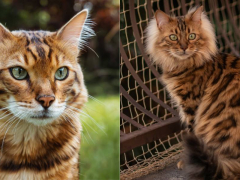
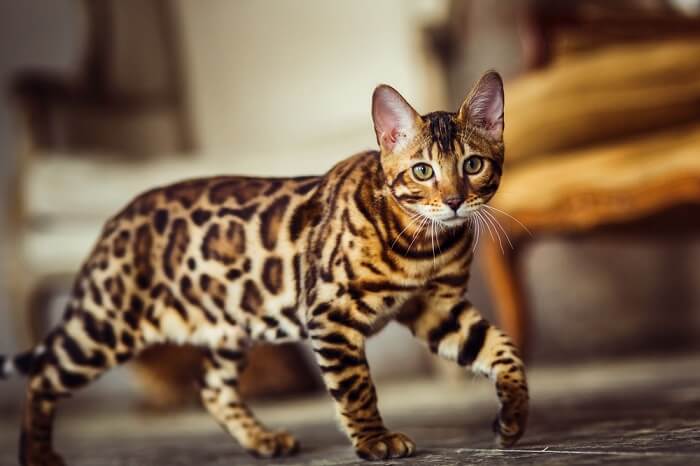
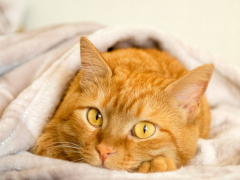

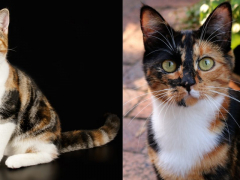




On time spent with my cat who is a bombay. How much time is good? Currently I spend about 4 to 5 hours a day with him now. The rest of the time I’m around but not always with him. He loves the oustside but I bring him in at night. He seems very happy and loving I just wanted make sure my time with him is enough.
The amount of time spent on social interactions varies based on the individual cat. If you’re letting him outside, you should be out there with him. Harness/leash train him and make it more bonding time. It’s highly unsafe to leave a cat outside on his or her own, as it opens up the possibility of human cruelty (especially with black cats because many people still harbor superstitious nonsense about them, thinking they’re “evil”), wildlife (they have a lot of predators and they also kill too many birds), weather, and simply being able to find them if there’s an emergency and you need to leave (because he should absolutely be brought inside then), and of course with such an attractive breed. It’s also a matter of life-or-death to keep a cat that goes outdoors on Revolution. It’s (as far as I know) the best protection for fleas, ticks, and mosquitos. Mosquitos carry heartworms (and can infect with a single bite), which are 100% fatal to cats. A heartworm infection is bad for dogs, who must undergo traumatizing treatments to be cured, but there is no cure for a feline heartworm infection. Their sensitive little bodies can’t handle the chemical cocktail given to dogs.
Cats like having solo time, nap time, play time, cuddle time, and food time. If your cat is getting a good balance of those things and seems happy/loving and healthy, you’re probably okay.
Most importantly, make sure you’re feeding him adequate food (at the very least, it should be high protein with taurine), giving him access to plenty of clean/fresh water, and taking him to the vet for checkups at least once every six months. You should also have annual dental cleanings done at the vet’s, along with full blood panels twice yearly.
Good luck!
Great comment, Veronica. Thanks for sharing!
i have my own Bombay laid up on me right now, i am so in love! any tips for introducing him to my two, big Doggers?! i love them all so very much!!!
Hi Erin,
Mallory just did a wonderful video on the topic a couple of weeks ago, check it out here:
https://www.youtube.com/watch?v=3cJD3tsvKgQ
i have my own Bombay laid up on me right now, i am so in love! any tips for introducing him to my two, big Doggers?! i love them all so very much!!! [:
Great question, Erin! The truth is there are a lot of factors at play here. One of which is your dogs’ personalities. Are they very excitable? Have they been around cats before? If you’re not sure how they’ll react, it may be best to go the extra cautious route.
Start by putting them in rooms next to each other and feed them a meal on either side of the door so they get used to being in proximity. Once everyone can eat calmly, introduce them in a neutral room with your dogs on a leash and the cat roaming free (neutral room meaning not your cat’s sanctuary and not the room your dogs have claimed). Throughout the encounter, ask your dogs to sit and reward them each time they do – this will help teach them calm behavior around the cat. Be sure to give your cat some treats as well.
Repeat these sessions daily, keeping them short enough that no one gets aggressive or anxious. It may help to save the tastiest treats for these sessions. When the sessions start going well, let the animals loose together but keep your dog’s leash on in case you need to step in quickly. You can always go back to the previous step if things get tense. From there it’s just a matter of time. Depending how calm the pets are with each other, you may still want to separate them when you aren’t home to supervise.
Good luck with your beautiful Bombay and your pups!
I have a Bombay (Pinkeyboy) who attacks my other male cat every chance he gets. He was abandoned as a kitten and found up in a tree; probably never learned how to adequately socialize. He’s very territorial and jealous if the other cat gets close to me. They both can eat together and be fine. Then the Bombay cat begins to seriously hurt and attack my older, gentle cat who is now quite scarce around the house because of this. What would you suggest: medication, shock collar and training or reintroducing them? I’m really at my wits end.
Thanks for your help.
Hi Sue, thanks for commenting. This is a really difficult situation. I would advise reintroduction as the gentlest first step, making sure that you provide lots of separate resources for each of them—food and water bowls, litter, sleeping spots, hiding places, trees, etc. I know they’re eating together and seem fine, but I do wonder if there are any other hot spots or territorial tensions building up that you’re not aware of. Of course, you can’t provide a clone for yourself so both cats can spend time with you at once, so that’ll be a challenge regardless. You might find our article on aggression in cats helpful.
I bealeve i have a Bombay cat she has a lot of the Charistics except she has green eyes and between me and my husband she follows me around like my shadow my husband when she feels like it not so much I adopted her from human susity when she was 9weeks but owner before was cruel to her but she is my baby I love her can you tell me if she is a bombay
No, I can’t! Officially, no cat can be considered a purebred unless they have paperwork from a breeder, and there’s no way we can make that assumption without a pedigree. Your cat is most likely a black non-purebred cat with green eyes and an attached disposition.
I have a beautiful cat…Lucky. I believe he is a Bombay. We chose each other from a rescue (Faithful Friends) I believe he was given to them as he….he someone’s eyes was not perfect. His tail was fractured in three places (they did not know what caused it….that is how he was given to them. To me he is perfect wheather he is a Bombay or not. He is just beautiful. He has all of the attributes black nose and toes pads, rounded ears, however, as I noted I love him,
My Cat Murphy is 15yrs of age, is a big boy weighs 20 lbs. Has been very vocal in his box when defecating. Stool is soft and good amt. When he is being vocal, you would swear I’m killing him! It’s heart breaking to hear every nite. Made a video of his vocalization for the Vet. She did not respond. Suggestions?
Have you ruled out vision issues, deafness, or dementia? Loud meowing can be connected to these, and I wonder if he feels particularly vulnerable when in the litter box. Is this only at night, or only when he does “number two”? Does he also meow loudly at any other time?
I adopted a kitten from a local shelter who was described as a Bombay. That didn’t matter to me, but she has every characteristic listed for Bombay cats. All this to say that rescue kittens can be just as good if not better than buying a breed cat.
My cat resembles a Bombay with the silky shiny thick coat. And loves to be brushed does not liked to be held and is a little aggressive toward me at bed time has jumped up and grabbed my arm and has bitten. Had to use a spray bottle to get into bed. He’s better now maybe because he’s getting older
Thanks for sharing, Ginny, it sounds like your Bombay is a handful! If you’re still struggling at bed time, we’d recommend trying methods that don’t involve punishment (like the spray bottle). This method can be frightening for some cats and positive-reinforcement methods often offer more long-term success. We have an article on reasons to avoid punishment for cats and some alternatives here: https://cats.com/cat-punishment